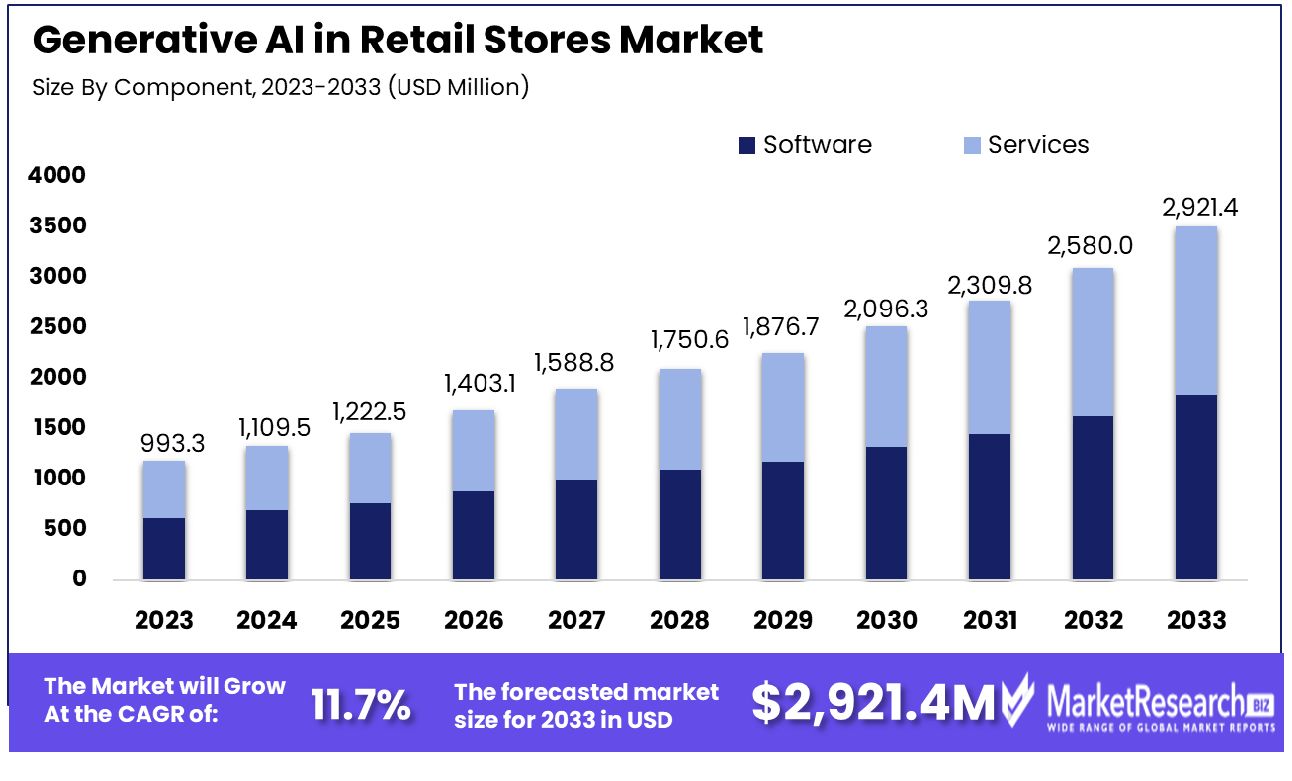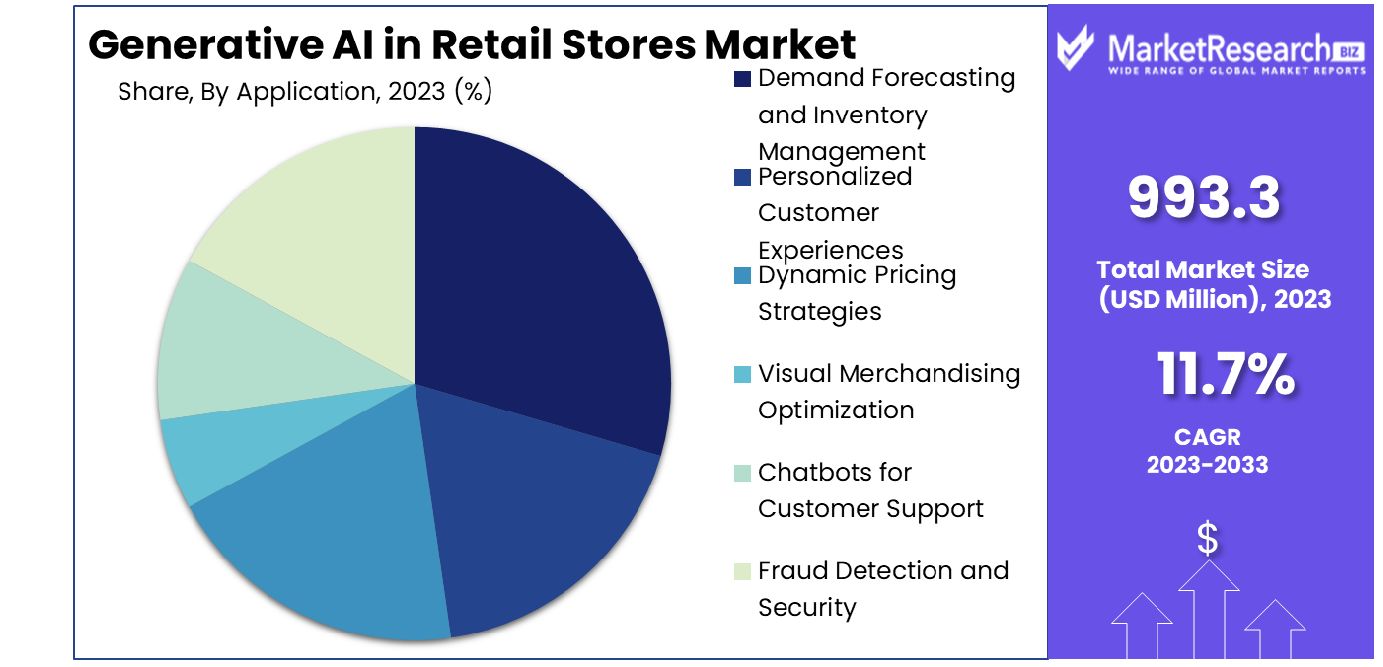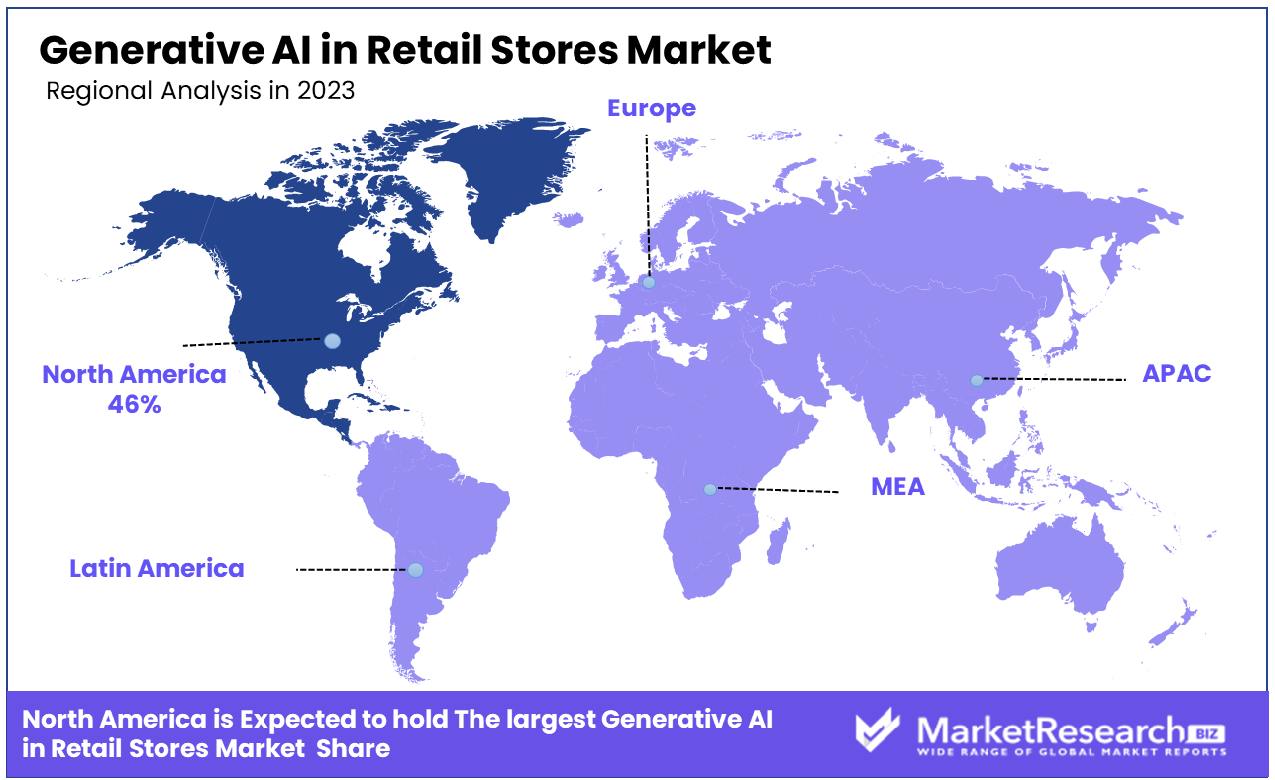
Generative AI in Retail Stores Market By Component(Software, Services), By Application(Demand Forecasting and Inventory Management, Personalized Customer Experiences, Dynamic Pricing Strategies, Visual Merchandising Optimization, Chatbots for Customer Support, Fraud Detection and Security), By Region And Companies - Industry Segment Outlook, Market Assessment, Competition Scenario, Trends, And Forecast 2024-2033
-
43258
-
Feb 2024
-
177
-
-
This report was compiled by Vishwa Gaul Vishwa is an experienced market research and consulting professional with over 8 years of expertise in the ICT industry, contributing to over 700 reports across telecommunications, software, hardware, and digital solutions. Correspondence Team Lead- ICT Linkedin | Detailed Market research Methodology Our methodology involves a mix of primary research, including interviews with leading mental health experts, and secondary research from reputable medical journals and databases. View Detailed Methodology Page
-
Quick Navigation
Report Overview
The Generative AI in Retail Stores Market was valued at USD 993.3 Million in 2023. It is expected to reach USD 2,921.4 Million by 2033, with a CAGR of 11.7% during the forecast period from 2024 to 2033.
The Generative AI in Retail Stores Market encompasses the deployment of advanced artificial intelligence technologies capable of generating new content, predictions, and decisions autonomously within the retail sector. This market is defined by its utilization of AI to optimize inventory management software, personalize customer experiences, enhance visual merchandising, and streamline operational efficiencies.

The strategic incorporation of Generative AI represents a pivotal opportunity to drive innovation, improve customer satisfaction, and gain a competitive edge. The growth of this market can be attributed to the increasing demand for tailored shopping experiences and the need for retailers to leverage data for strategic decision-making.
The integration of Generative AI in the retail sector is poised to revolutionize the landscape of physical retail stores, offering a transformational shift in how retailers engage with customers, manage inventory, and personalize shopping experiences. In the context of robust growth within the global retail market, which saw an increase of nearly 7% in 2022, reaching total sales of $28.195 trillion, the potential for Generative AI to enhance operational efficiencies and customer satisfaction is significant. This uptick in global retail sales underscores the vibrant economic activity and consumer spending resilience, providing a fertile ground for the adoption of advanced technologies such as Generative AI.
Moreover, with the United States hosting approximately 1.045 million physical retail stores as of 2020, the scale of opportunity for deploying Generative AI solutions is vast. These technologies can be leveraged to optimize supply chains, forecast demand more accurately, and offer highly personalized shopping experiences that can significantly enhance customer engagement and loyalty. Generative AI's ability to generate realistic product images, descriptions, and virtual assistants can also bridge the gap between online and in-store shopping experiences, offering a seamless customer journey.
From the perspective of a market research analyst, it is evident that the integration of Generative AI into retail stores not only aligns with the current growth trajectory of the retail market but also represents a strategic innovation vector for retailers aiming to differentiate themselves in a competitive landscape. As retailers navigate the complexities of the digital age, Generative AI stands out as a pivotal technology that can drive significant value, enhancing both operational efficiencies and the consumer shopping experience. In conclusion, the forward-looking adoption of Generative AI in retail stores is a testament to the sector's evolution towards more intelligent, responsive, and personalized retail environments.
Key Takeaways
- Market Growth: Generative AI in Retail Stores Market was valued at USD 993.3 Million in 2023. It is expected to reach USD 2,921.4 Million by 2033, with a CAGR of 11.7% during the forecast period from 2024 to 2033.
- By Component Analysis: Software dominates the Generative AI retail market with a 60% share.
- By Application Analysis: Demand Forecasting and Inventory Management lead at 25% application share.
- Regional Dominance: North America's commanding 46% share in the Generative AI in Retail Stores Market.
- Growth Opportunity: Generative AI boosts supply chain efficiency and creates immersive shopping, driving retail growth through operational optimization and enhanced customer experiences.
Driving factors
Hyper-Personalization Fuels Market Expansion
The demand for hyper-personalization in retail, powered by Generative AI, is a critical driver for market growth. Generative AI's capability to tailor product recommendations, promotions, and store layouts for each shopper addresses the growing consumer expectation for personalized shopping experiences.
With 96% of retail executives inspired by its potential, this technology is not merely an option but a necessity for staying relevant. The push for personalization leads to enhanced customer satisfaction and loyalty, thereby increasing sales and revenue. This factor, coupled with competitive pressures, encourages retailers to innovate continuously, fostering a market environment ripe for rapid growth and transformation.
Demand for New Shopping Experiences Elevates Market Dynamics
Generative AI is revolutionizing the retail sector by introducing novel shopping experiences such as virtual dressing rooms, 3D product previews, and conversational interfaces. These innovations not only enhance customer engagement but also set a new standard for the shopping journey.
Retailers leveraging these technologies can offer unparalleled customer experiences, making them stand out in a crowded market. This demand for innovative shopping experiences drives retailers to adopt generative AI solutions, thus accelerating market growth. The integration of these experiences with hyper-personalization strategies further amplifies their impact, creating a synergistic effect that boosts customer retention and attracts new shoppers.
Competitive Differentiation Spurs Market Innovation
The adoption of generative AI for competitive differentiation is a potent catalyst for growth in the retail stores market. Early adopters gain a significant advantage by optimizing operations, such as demand forecasting, inventory management, and product design, thereby enhancing productivity by 1.2 to 2.0 percent according to McKinsey. This competitive edge not only drives market leaders to invest in AI but also compels the rest of the industry to follow suit or risk obsolescence.
The ripple effect of this competitive pressure accelerates the widespread implementation of generative AI technologies across the retail sector, fostering an environment of continuous innovation and growth. This trend is expected to redefine market standards, pushing retailers toward a more efficient, personalized, and innovative future.
Restraining Factors
Implementation Costs Restrain Market Growth
The high costs associated with implementing generative AI technologies pose a significant barrier to market growth. Developing and integrating these complex systems necessitate substantial investments in data infrastructure and AI talent, alongside the expenses of managing the change within organizations.
For many retailers, especially small to medium-sized enterprises, these upfront costs are prohibitively high, limiting their ability to adopt and benefit from generative AI. This financial challenge discourages widespread adoption, slowing down the pace of innovation and expansion within the retail market. The high-cost barrier ensures that only well-funded retailers can afford to explore and implement these cutting-edge technologies, leaving a gap in market penetration and innovation.
Immature Technology Restrains Market Growth
Generative AI, while promising, is still in its nascent stages of development and not yet advanced enough for comprehensive adoption across all retail operations. This immaturity limits the technology's application in areas that require sophisticated understanding and automation, such as full automation of store operations. Retailers, cautious of investing in technologies that may not deliver immediate or full-scale benefits, might opt to wait for further advancements.
This hesitation slows down the adoption rate and, consequently, the growth of the generative AI market in retail. The gap between the technology's potential and its current capabilities creates a restraint on market expansion as retailers look for more mature, reliable solutions.
By Component Analysis
Software emerges as the dominant sub-segment within the Generative AI in the Retail Stores Market, accounting for 60% of the market share. This dominance can be attributed to the critical role software plays in enabling the core functionalities of generative AI, from data processing and analysis to the generation of insights and automated actions. Retailers rely on sophisticated software solutions to integrate generative AI capabilities into their operations, enhancing efficiency, customer engagement, and innovation. The software segment's growth is propelled by the increasing demand for advanced analytics, personalized shopping experiences, and operational automation.
The development and deployment of generative AI software are foundational to realizing the technology's potential in areas such as personalized marketing, inventory management, and customer service. As retailers seek to differentiate themselves in a competitive market, the demand for software that can provide a tailored, innovative shopping experience increases. Furthermore, software solutions facilitate the analysis of vast amounts of data, enabling retailers to uncover insights about consumer behavior, preferences, and trends.
The services segment, although not the dominant sub-segment, plays a crucial role in the growth of the generative AI market by providing the necessary support for the implementation, maintenance, and optimization of software solutions. Services such as consulting, integration, and support are vital for retailers, especially those with limited technical expertise, to effectively leverage generative AI technologies. Together, software and services form a comprehensive ecosystem that drives the adoption and efficacy of generative AI in retail.
By Application Analysis
Demand Forecasting and Inventory Management is the leading application sub-segment, occupying 25% of the market. This dominance underscores the critical importance of optimizing inventory levels and predicting consumer demand in the retail industry. Generative AI plays a pivotal role in transforming these areas by leveraging data analytics and machine learning to forecast trends, manage stock levels efficiently, and minimize overstock and understock situations. This capability not only improves operational efficiency but also significantly reduces costs and increases customer satisfaction by ensuring product availability.

The precision and agility offered by generative AI in forecasting and inventory management enable retailers to respond swiftly to market changes, align inventory with consumer demand patterns, and optimize supply chain operations. This strategic advantage is crucial in today's fast-paced retail environment, where consumer preferences and market dynamics are constantly evolving.
Other application segments, such as Personalized Customer Experiences, Dynamic Pricing Strategies, Visual Merchandising Optimization, Chatbots for Customer Support, and Fraud Detection and Security, contribute to the market's growth by enhancing various aspects of the retail experience. Personalized Customer Experiences, for instance, leverage generative AI to offer customized shopping journeys, while Dynamic Pricing Strategies use AI to adjust prices in real time based on market demand and competition.
Visual Merchandising Optimization and Chatbots for Customer Support improve the shopping experience and operational efficiency, respectively. Fraud Detection and Security applications ensure the integrity and safety of transactions. Each of these segments, though not as dominant as Demand Forecasting and Inventory Management, plays a significant role in enriching the retail environment and driving the adoption of generative AI technologies.
Key Market Segments
By Component
- Software
- Services
By Application
- Demand Forecasting and Inventory Management
- Personalized Customer Experiences
- Dynamic Pricing Strategies
- Visual Merchandising Optimization
- Chatbots for Customer Support
- Fraud Detection and Security
Growth Opportunity
Enhanced Supply Chain Optimization Offers Growth Opportunity
Generative AI's role in optimizing supply chains presents significant growth opportunities for the retail stores market. By accurately predicting demand, automating reorder decisions, and refining logistics planning, AI technologies address critical retail pain points such as out-of-stock, excess inventory, and elevated delivery costs.
This optimization leads to more efficient operations, cost savings, and improved customer satisfaction. Retailers can leverage these benefits to enhance their competitive edge, streamline operations, and reduce wastage, thereby driving market growth. The adoption of generative AI in supply chain management not only increases operational efficiency but also supports sustainability efforts by minimizing excess inventory and optimizing delivery routes.
Immersive Shopping Environments Offer Growth Opportunity
The creation of engaging, interactive virtual and augmented reality shopping environments through generative AI offers a substantial growth opportunity in the retail sector. These immersive experiences attract customers seeking novel shopping formats, differentiating retailers in a crowded market. By providing unique, personalized shopping experiences, retailers can increase customer engagement, enhance brand loyalty, and drive sales.
The capability to virtually try on clothes, preview products in a home setting, or navigate a digital store adds value to the customer journey, encouraging repeated engagement and potentially increasing conversion rates. This technological advancement allows retailers to tap into new customer segments and elevate the shopping experience beyond traditional physical and online platforms.
Latest Trends
Automated Store Operations Is a Trending Factor
Automating repetitive in-store tasks such as shelf stocking, inventory checking, and cashier operations through generative AI represents a significant opportunity to reduce operational costs and enhance efficiency. This automation addresses retailers' challenges with high labor costs and inefficient processes, allowing staff to focus on more value-added activities like customer service and sales.
The reduction in operational expenses and improvement in in-store efficiency can significantly impact profitability and customer satisfaction. Retailers that embrace automation can redefine the in-store experience, making it more efficient and enjoyable for customers, thereby driving foot traffic and loyalty in a competitive landscape.
New Business Models and Revenue Streams
Generative AI enables innovative business models and revenue streams, such as subscription services, on-demand manufacturing, and dynamic pricing, presenting fresh opportunities for top-line growth in the retail sector. These models allow retailers to offer personalized, convenient, and flexible shopping options, catering to evolving consumer preferences.
Subscription services foster customer loyalty and predictable revenue, while on-demand manufacturing reduces inventory risk and waste. Dynamic pricing optimizes revenue based on demand and market conditions. By adopting these new business models, retailers can tap into unexplored markets, meet changing consumer demands, and secure a competitive advantage, driving sustainable growth and market expansion.
Regional Analysis
North America Dominates with 46% Market Share
North America's commanding 46% share in the Generative AI in Retail Stores Market is attributable to several key factors. The region's technological advancement, robust digital infrastructure, and high adoption rate of AI and machine learning technologies are primary drivers.

North America, particularly the United States, hosts a large number of generative AI startups and tech giants investing heavily in AI research and applications in retail. Furthermore, the region's retailers are keen on leveraging AI to enhance customer experiences and operational efficiencies, contributing to the market's growth. The high consumer spending power and openness to adopting new technologies also play significant roles in this dominance.
Europe Showcases Significant Market Influence
Europe holds a substantial portion of the Generative AI in Retail Stores Market, driven by its strong focus on innovation and digital transformation in retail. The region's stringent data protection regulations, like GDPR, have also encouraged the development of AI solutions that prioritize consumer privacy and data security, appealing to both retailers and consumers.
Europe's diverse retail landscape, with a mix of traditional and online retailing, provides a fertile ground for implementing generative AI applications, from personalized shopping experiences to efficient supply chain management. The region's commitment to sustainability and ethical AI use further strengthens its position in the global market, setting standards for responsible AI deployment.
Asia-Pacific Emerges as a Dynamic Player
The Asia-Pacific region is rapidly emerging as a dynamic player in the Generative AI in Retail Stores Market, with its fast-growing economies, expanding middle class, and increasing digitalization. Countries like China and Japan are leading in AI technology development and application, driven by substantial investments from both public and private sectors.
The region's vast and growing internet user base offers a vast potential for e-commerce and retail innovation through AI. Moreover, Asia-Pacific's unique consumer behaviors and preferences encourage the adoption of generative AI solutions tailored to local markets. The region's agility in adopting new technologies, combined with its economic growth, positions it as a significant contributor to the global market's expansion.
Key Regions and Countries
North America
- The US
- Canada
- Rest of North America
Europe
- Germany
- France
- The UK
- Spain
- Netherlands
- Russia
- Italy
- Rest of Europe
Asia-Pacific
- China
- Japan
- Singapore
- Thailand
- South Korea
- Vietnam
- India
- New Zealand
- Rest of Asia Pacific
Latin America
- Mexico
- Brazil
- Rest of Latin America
Middle East & Africa
- Saudi Arabia
- South Africa
- UAE
- Rest of Middle East & Africa
Key Players Analysis
In the Generative AI in Retail Stores Market, the presence of major technology firms like IBM Corporation, NVIDIA Corporation, Microsoft Corporation, Google LLC, Salesforce, Amazon Web Services (AWS), SAS Institute Inc., Adobe Inc., SAP SE, and Cognizant Technology Solutions Corporation, alongside other key players, underscores a competitive and dynamic landscape. These companies are pivotal in driving innovation, offering a range of solutions that enhance customer experiences, optimize operations, and enable new business models within the retail sector.
IBM and Microsoft are renowned for their robust AI platforms and cloud services that support retail analytics and customer insights. NVIDIA, with its advanced GPU technologies, powers AI and machine learning algorithms critical for data-intensive tasks. Google and AWS offer expansive cloud infrastructure and AI services that facilitate scalable, efficient generative AI applications.
Salesforce and Adobe stand out for their customer relationship management and creative solutions, respectively, tailored to create personalized customer experiences. SAP and SAS provide enterprise resource planning and analytics solutions that improve supply chain efficiency and decision-making. Cognizant, along with other key players, offers customized AI solutions that address specific retail challenges.
Market Key Players
- IBM Corporation
- NVIDIA Corporation
- Microsoft Corporation
- Google LLC
- Salesforce
- Amazon Web Services (AWS)
- SAS Institute Inc.
- Adobe Inc.
- SAP SE
- Cognizant Technology Solutions Corporation
- Other key players
Recent Development
- In February 2024, Fulcrum Digital will unveil Ryze, an advanced Generative AI platform, revolutionizing content generation across industries with tailored solutions and seamless integration. Ryze promises unparalleled precision and efficiency in textual and visual mediums.
- In February 2024, Amazon introduces Rufus, a generative AI-powered shopping assistant, offering personalized recommendations, product comparisons, and improved shopping experiences for select users in the US.
- In February 2024, Ikea introduced a new generative AI shopping tool accessible through ChatGPT, enabling users to inquire about products, receive design tips, and explore furnishings within specific parameters.
- In December 2023, Kleep, the AI-based size recommendation solution, successfully secured €1.8 million in a recent funding round from various investors. Launched in June 2023, Kleep aims to utilize the funds to accelerate its growth and develop a product search website utilizing AI. The technology not only assists fashion labels in implementing precise size suggestion systems but also addresses the challenge of returns from online clothing purchases.
Report Scope
Report Features Description Market Value (2023) USD 993.3 Million Forecast Revenue (2033) USD 2,921.4 Million CAGR (2024-2032) 11.7% Base Year for Estimation 2023 Historic Period 2016-2023 Forecast Period 2024-2033 Report Coverage Revenue Forecast, Market Dynamics, COVID-19 Impact, Competitive Landscape, Recent Developments Segments Covered By Component(Software, Services), By Application(Demand Forecasting and Inventory Management, Personalized Customer Experiences, Dynamic Pricing Strategies, Visual Merchandising Optimization, Chatbots for Customer Support, Fraud Detection and Security) Regional Analysis North America - The US, Canada, Rest of North America, Europe - Germany, France, The UK, Spain, Italy, Russia, Netherlands, Rest of Europe, Asia-Pacific - China, Japan, South Korea, India, New Zealand, Singapore, Thailand, Vietnam, Rest of Asia Pacific, Latin America - Brazil, Mexico, Rest of Latin America, Middle East & Africa - South Africa, Saudi Arabia, UAE, Rest of Middle East & Africa Competitive Landscape IBM Corporation, NVIDIA Corporation, Microsoft Corporation, Google LLC, Salesforce, Amazon Web Services (AWS), SAS Institute Inc., Adobe Inc., SAP SE, Cognizant Technology Solutions Corporation, Other key players Customization Scope Customization for segments, region/country-level will be provided. Moreover, additional customization can be done based on the requirements. Purchase Options We have three licenses to opt for Single User License, Multi-User License (Up to 5 Users), Corporate Use License (Unlimited User and Printable PDF) -
-
- IBM Corporation
- NVIDIA Corporation
- Microsoft Corporation
- Google LLC
- Salesforce
- Amazon Web Services (AWS)
- SAS Institute Inc.
- Adobe Inc.
- SAP SE
- Cognizant Technology Solutions Corporation
- Other key players




